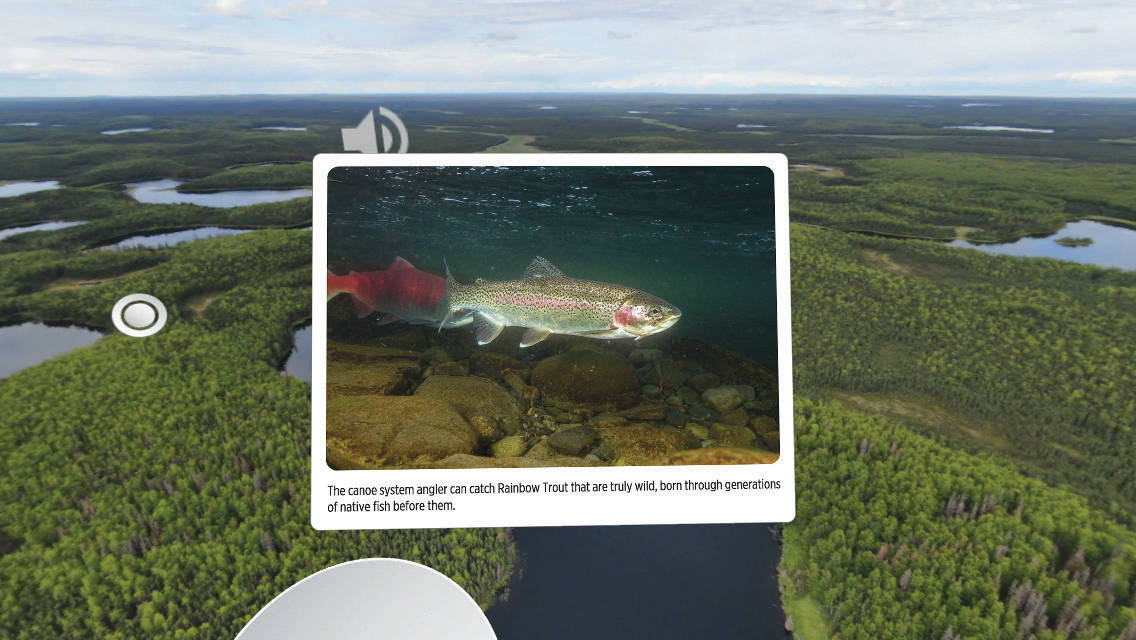Visiting Tustumena Glacier. Sitting at the top of Skyline Trail. Hovering, like a bird, above Paddle Lake.
All of these vantage points in the Kenai National Wildlife Refuge are now just minutes away for anyone with a modern enough smartphone or tablet, and cellphone or internet service.
Last week, the Kenai National Wildlife Refuge launched its newest exhibit on the Timelooper app.
Leah Eskelin, visitor services park ranger at the refuge, said the virtual-reality exhibit was originally supposed to open at the refuge’s visitor center.
The visitor center remains closed due to the new coronavirus pandemic. Eskelin said due to the closure, the refuge prioritized getting the exhibit in the hands of people via smartphone or tablet.
“I’m very excited to have a virtual exhibit of this caliber,” Eskelin said.
Start by downloading the Timelooper app. Launch the app and a series of icons will appear. Select “Alaska Wilderness.”
Here the Timelooper app recommends a cardboard virtual reality headset and headphones for a better experience, but the user can decline this option and operate the app with just a smartphone or tablet.
The user is transported into the refuge visitor center and prompted to gaze at a speaker icon for a few seconds. This triggers a recorded introduction to the exhibit.
The user can then gaze at one of three icons in the visitor center and be transported to 360-degree, virtual-reality experiences at Tustumena Glacier, Paddle Lake or Skyline Trail.
The theme of the exhibit is Kenai Wilderness, which makes up 1.32 million acres of the 1.92-million-acre refuge. The Kenai Wilderness was established by the 1980 Alaska National Interest Lands Conservation Act, which also re-designated the Kenai National Moose Range as the Kenai National Wildlife Refuge.
The Wilderness Act was signed into law by President Lyndon B. Johnson 56 years ago this week. Eskelin said the virtual reality exhibit went live on Timelooper last week and is being promoted this week as part of a commemoration of the signing of the Wilderness Act.
Eskelin said wilderness land is defined as undeveloped, untrammeled and protected in its natural state.
“These are special places that give solitude and oneness with nature without things like generators and electric motors going,” she said.
The refuge has three wilderness units.
The Dave Spencer Unit is 187,228 acres and is located in the northern part of the refuge. Its forests, lakes and meadows are featured in the Swan Lake and Swanson River canoe trails.
Eskelin said the 360-degree aerial shot just happened to be above Paddle Lake.
“We’re interested not in that specific location on the map, but getting the essence of the entire unit,” she said. “The canoe systems and a look at the glacially formed lake landscape, and also the culture and history of the area.”
The Andrew Simons Unit is 1,087,094 acres. It includes part of the Harding Icefield, as well as the area between Tustumena and Skilak lakes. The shot from Tustumena Glacier allows views of the icefield, as well as the drainage to Tustumena Lake.
The Mystery Creek Unit is 46,086 acres in the Kenai Mountains, represented by the summit shot of Skyline.
Eskelin said the exhibit is meant to provide access to those without planes, boats or a good set of hiking legs, but also inspiration for those who do have the ability to visit those spots.
“It gives a peak into what wilderness on the Kenai provides for our visitors and also lets them understand how special the landscape is,” she said.
Eskelin said the images were taken a few months ago by Alaska Geographic, a nonprofit that partners with refuges, parks and forests in Alaska.
In each of the three units, the user can focus on points of interest to learn more about the animals, plants and culture of the unit.
“Not only is this a beautiful, inspirational view,” Eskelin said. “There’s more of a story to the landscape that’s important to cultural heritage.”
Eskelin said this exhibit is another step in the refuge’s use of virtual reality. She said the journey started a few years ago when the refuge began using 360-degree photos to take wilderness experiences to extended living facilities and classrooms.
“It’s never quite the same thing as being there, but the technology is getting to the point where you can use it to at least give an inspirational experience,” Eskelin said.
When the virtual reality exhibit goes in at the visitor center, Eskelin said visitors will get a high-definition, immersive experience that isn’t possible with a cardboard virtual reality headset.
The exhibit also has plenty of opportunity to expand in content. Eskelin said the Timelooper app is great at showing changes over time, which opens up possibilities on topics like forest succession and land development.
Eskelin said anybody with more questions about the app can contact the visitor center at 907-260-2820.

